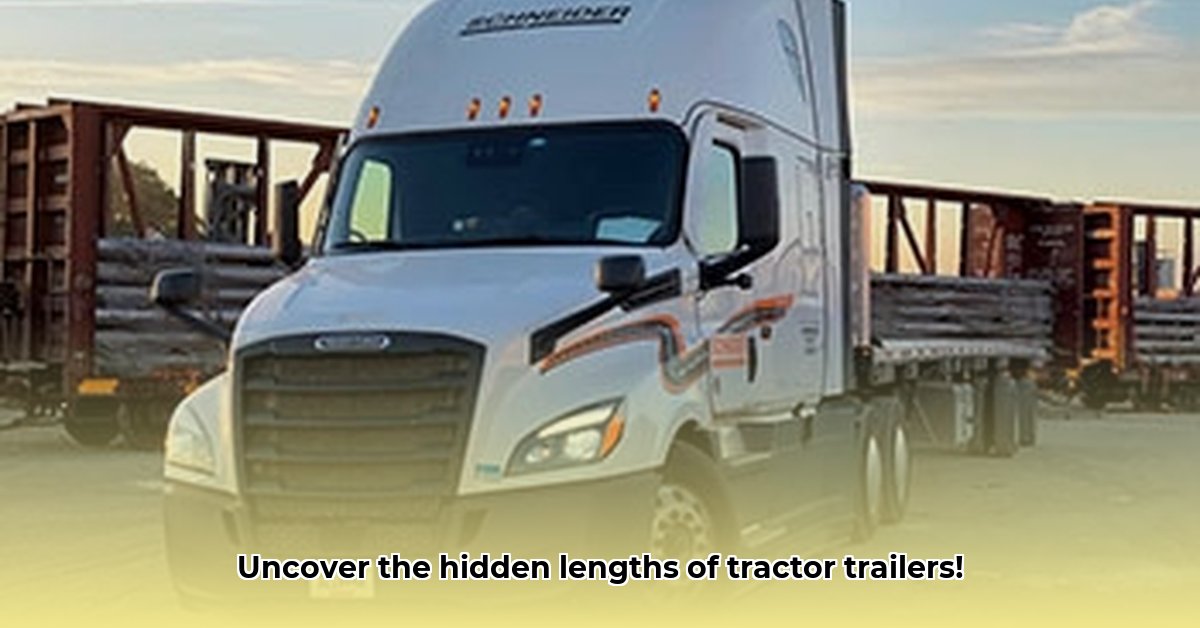
Understanding tractor-trailer dimensions is crucial for drivers, logistics professionals, and anyone involved in the transportation industry. This guide provides a comprehensive overview of standard sizes, state-by-state regulations, and the process of obtaining permits for oversized loads. For more detailed information, check out this helpful resource on tractor trailer dimensions.
Standard Tractor-Trailer Dimensions
The dimensions of a tractor-trailer significantly impact its maneuverability, route planning, and legal compliance. Let's examine the typical measurements:
Typical Tractor-Trailer Length
The length of a typical tractor-trailer combination varies depending on the trailer type. A standard dry van trailer is approximately 53 feet long. Adding the tractor (cab), the total length increases to roughly 70-80 feet. This substantial length requires careful consideration when navigating roads and making turns.
Common Trailer Types and Dimensions
Various trailer types cater to different cargo needs, leading to size variations:
- Dry Van Trailers: These are the most common type, typically 53 feet long, 8.5 feet wide, and 13.5 feet high. (Standard cargo containers).
- Pup Trailers: Smaller trailers, approximately 28 feet long, ideal for smaller loads or tighter spaces. (Think of them as the compact cars of trucking.)
- Flatbed Trailers: Designed for oversized or oddly shaped cargo; generally 48-53 feet long, sharing similar width and height with dry vans. (Ideal for items that don't fit in enclosed trailers.)
- Extendable Trailers: These can extend to over 80 feet or more, accommodating exceptionally long items. (Essential for transporting large machinery or building components).
Isn't it interesting how these variations influence logistics planning? Do you know which type is best suited for your shipping needs?
State-by-State Regulations: Navigating the Legal Landscape
While many states allow tractor-trailers up to 75 feet long, individual regulations vary significantly. This inconsistency necessitates meticulous route planning to ensure legal compliance. Failure to adhere to state-specific regulations can lead to significant delays and hefty fines. Consider the cost efficiencies of careful planning. What percentage of your budget is lost to unexpected delays and fines?
Oversized Loads: Permits, Planning, and Procedures
Transporting oversized loads requires special permits, comprehensive planning, and adherence to strict procedures.
Obtaining Oversize Trucking Permits: A Step-by-Step Guide
Securing permits for oversized loads involves several key steps:
- Measure Your Load: Accurately determine your cargo's dimensions and weight. Inaccurate measurements can lead to permit rejection.
- Plan Your Route: Carefully select your route, accounting for bridge clearances, weight restrictions, and state-specific route limitations.
- Research State Regulations: Consult each state's Department of Transportation (DOT) website for specific regulations.
- Complete the Application: Fill out the state's application form accurately and completely, avoiding omissions.
- Submit and Pay: Submit the completed application and pay the required fees; many operate online. Remember to retain your confirmation.
- Receive Your Permit: Upon approval, you'll receive your permit. Do not commence transport without it.
"Careful route planning and accurate permit applications are paramount to ensuring legal operation and minimizing delays," says Dr. Emily Carter, Professor of Transportation Engineering at MIT.
Tips for a Smooth Permit Process:
- Plan Ahead: Begin the process well in advance of your transport date to accommodate potential delays.
- Maintain Records: Keep meticulous records of your application, payments, and permit.
- Utilize Technology: Leverage online tools, software, and route optimization platforms.
- Seek Expert Assistance: For complex multi-state shipments, consider professional logistics assistance.
Conclusion: Safety and Efficiency Through Dimensional Awareness
Accurate knowledge of tractor-trailer dimensions is vital for safe and efficient transportation. Understanding state regulations and permit requirements is essential for compliance and avoiding costly delays. Thorough planning and adherence to these guidelines ensure the success of any transportation endeavor. Are you maximizing your operational efficiency by adhering to these practices?